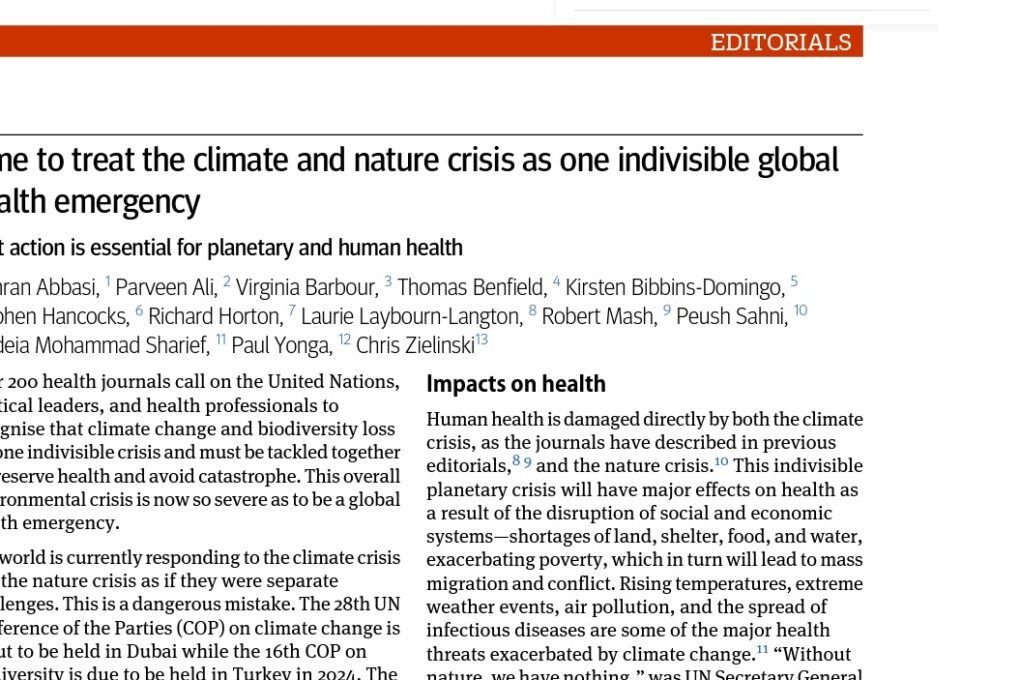Over 200 health journals across the world have come together to simultaneously publish an editorial calling on world leaders and health professionals to recognise that climate change and biodiversity loss are one indivisible crisis and must be tackled together to preserve health and avoid catastrophe.
The authors say it’s a “dangerous mistake” to respond to the climate crisis and the nature crisis as if they were separate challenges, and urge the World Health Organization to declare this indivisible crisis as a global health emergency.
The editorial is published in leading titles from around the world, including The BMJ, The Lancet, JAMA, the Medical Journal of Australia, the East African Medical Journal, the National Medical Journal of India and Dubai Medical Journal.
Human health is damaged directly by both the climate crisis and the nature crisis, with the poorest and most vulnerable communities often bearing the highest burden, they write. Rising temperatures, extreme weather events, air pollution, and the spread of infectious diseases are some of the major health threats exacerbated by climate change.
For example, access to clean water is fundamental to human health, yet pollution has damaged water quality causing a rise in water-borne diseases, and ocean acidification has reduced the quality and quantity of seafood that billions of people rely on for food and their livelihoods. Biodiversity loss also undermines good nutrition and constrains the discovery of new medicines derived from nature, while changes in land use have forced tens of thousands of species into closer contact, increasing the exchange of pathogens and the emergence of new diseases and pandemics.
Communities are healthier if they have access to high-quality green spaces that help filter air pollution, reduce air and ground temperatures, and provide opportunities for physical activity. Connecting with nature also reduces stress, loneliness and depression while promoting social interaction – benefits that are threatened by the continuing rise in urbanisation.
In December 2022 the biodiversity conference (COP) agreed on the effective conservation and management of at least 30% percent of the world’s land, coastal areas, and oceans by 2030. Yet the authors note that the climate and nature scientists who provide the evidence for COPs are largely separate and many commitments have not been met.
“This has allowed ecosystems to be pushed further to the brink, greatly increasing the risk of breakdowns in the functioning of nature,” they warn. “Even if we could keep global warming below an increase of 1.5◦C over pre-industrial levels, we could still cause catastrophic harm to health by destroying nature.”
This risk, combined with the severe impacts on health already occurring, means the World Health Organization should declare the indivisible climate and nature crisis as a global health emergency, before or at the World Health Assembly in May 2024, they write.
Tackling this emergency requires the COP processes to be harmonised, they add. As a first step, the respective conventions must push for better integration of national climate plans with biodiversity equivalents.
Health professionals must be powerful advocates for both restoring biodiversity and tackling climate change for the good of health, while political leaders must recognise both the severe threats to health from the planetary crisis as well as the benefits that can flow to health from tackling the crisis, they say. “But first, we must recognise this crisis for what it is: a global health emergency. ”The journal editors have supported a petition calling for WHO to declare a global public health emergency at the World Health Assembly in May 2024, which has been launched to coincide with publication of the editorial.

Read the editorial

Publishing journals

